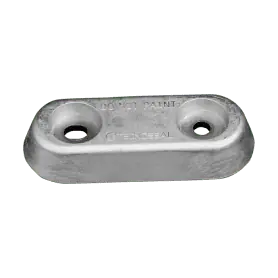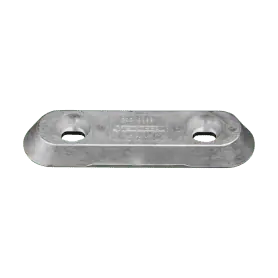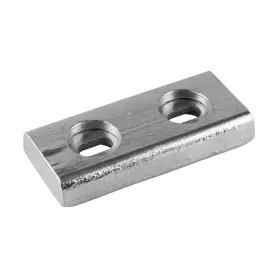List of products by brand Tecnoseal
Stern anode D.125 H38
€101.14
€155.60
-35%
Last items in stock
Sacrificial anodes are metal elements (usually made of zinc, aluminum, or magnesium alloy) used to protect metal structures from corrosion. Their operation is based on the principle of cathodic protection, where the anode is placed near the metal structure to be protected, forming an electrical circuit.
STERN FLANGE D.125 mm - H.38 mm - COMPLETE
€118.08
€181.66
-35%
In Stock
Sacrificial anodes are metal elements (usually made of zinc, aluminum, or magnesium alloy) used to protect metal structures from corrosion. Their operation is based on the principle of cathodic protection, in which the anode is positioned near the metal structure that needs protection, forming an electrical circuit.
AFT DISC ANODE DIAM. 100
€72.35
€111.31
-35%
Disponibile a breve
Sacrificial anodes are metal elements (usually made of zinc, aluminum, or magnesium alloys) used to protect metal structures from corrosion. Their operation is based on the principle of cathodic protection, where the anode is placed near the metal structure that needs to be protected, forming an electrical circuit.
FL POPPA DIA 135 H47 COMPLETE
€186.08
€286.27
-35%
In Stock
The zinc stern flange is designed to provide protection to the rear part of boats or other marine structures. With a diameter of 135 mm and a height of 47 mm, it is made of durable zinc to ensure long-lasting durability and reliable protection against corrosion caused by the marine environment. The flange is complete with M14 brass screws, which offer additional corrosion resistance and structural robustness. The PP cap provides a secure closure and the gasket ensures proper sealing, effectively protecting the rear part of the boat or structure from water infiltration. Ideal for Yachts & Superyachts.
ZN ANODE FOR STERN DIA 120 H.35
€101.91
€156.78
-35%
Disponibile a breve
ZN ANODE FOR STERN DIA 120 H.35
AFT DISC ANODE ø145
€121.00
€186.15
-35%
Disponibile a breve
Sacrificial anodes are metal elements (usually made of zinc, aluminum, or magnesium alloys) used to protect metal structures from corrosion. Their functioning is based on the principle of cathodic protection, where the anode is positioned near the metal structure that needs protection, forming an electrical circuit.
STERN FLANGE WITHOUT INSERT ø135
€95.96
€147.63
-35%
Last items in stock
Sacrificial anodes are metal elements (usually made of zinc, aluminum, or magnesium alloy) used to protect metal structures from corrosion. Their operation is based on the principle of cathodic protection, where the anode is placed near the metal structure that needs protection, forming an electrical circuit.
RUDDER AND FLAPS PLATE ANODE INT. 5 DIM.64X64
€11.28
€17.35
-35%
In Stock
Sacrificial anodes are metal elements (usually made of zinc, aluminum, or magnesium alloy) used to protect metal structures from corrosion. Their operation is based on the principle of cathodic protection, where the anode is placed near the metal structure to be protected, forming an electrical circuit.
FLAPS plate 110 X 67 X 20 F.7 CF 57
€26.04
€40.06
-35%
In Stock
Sacrificial anodes are metal elements (usually made of zinc, aluminum, or magnesium alloy) used to protect metal structures from corrosion. Their operation is based on the principle of cathodic protection, where the anode is placed near the metal structure that needs protection, forming an electrical circuit.
FLAPS PLATE 130 X 50 X 17
€19.98
€30.73
-35%
In Stock
Sacrificial anodes are metal elements (usually made of zinc, aluminum, or magnesium alloy) used to protect metal structures from corrosion. Their operation is based on the principle of cathodic protection, where the anode is placed near the metal structure that needs protection, forming an electrical circuit.
RECTANGULAR SERIES 73X48X15 C.F. 50 HOLE 7
€21.84
€33.60
-35%
In Stock
The rectangular plate for flaps and rudders is designed to provide a solid and durable base on which to mount flaps or rudders on boats. With dimensions of 73x48x10 centimeters and a strength of 50 kilograms per square centimeter, this plate offers a solid structure that can support the installation of various control and stabilization devices underwater. Made with resistant and durable materials, this plate ensures reliable stability and optimal performance in both normal marine conditions and more challenging situations.
FLAP PLATE OVAL 0.9 150 x 60 x 25
€25.87
€39.80
-35%
Last items in stock
FLAPS OVAL PLATE 0.9 150 x 60 x 25
FLAP PLATE OVAL 0.3 - 100 x 45 x 18
€17.80
€27.39
-35%
In Stock
Sacrificial anodes are metal elements (usually made of zinc, aluminum, or magnesium alloys) used to protect metal structures from corrosion. Their functioning is based on the principle of cathodic protection, where the anode is placed near the metal structure that needs protection, forming an electrical circuit.
Oval plate type Vetus Int. 14 length 247.
€62.77
€96.56
-35%
Last items in stock
Sacrificial anodes are metal elements (usually made of zinc, aluminum, or magnesium alloy) used to protect metal structures from corrosion. Their operation is based on the principle of cathodic protection, where the anode is positioned near the metal structure to be protected, forming an electrical circuit.
Hull plate VET 240x65x29 -
€62.77
€96.56
-35%
Last items in stock
The Vetus hull plate is an essential component for the stability and safety of boats. With dimensions of 250x63x29 millimeters and a maximum load capacity of 140 KG, it is designed to be robust and durable. It is ideal for installation on various types of boats, providing a secure and reliable anchorage for various components such as auxiliary motors, stern thrusters, rudders, or other equipment. With a buoyancy coefficient of 2.3, this plate ensures an optimal balance between stability and load capacity, allowing for smooth and safe navigation.
Vetus stern anode I.200
€68.84
€105.91
-35%
Last items in stock
Sacrificial anodes are metal elements (usually made of zinc, aluminum, or magnesium alloys) used to protect metal structures from corrosion. Their functioning is based on the principle of cathodic protection, where the anode is placed near the metal structure that needs to be protected, forming an electrical circuit.
OVAL PLATE 115 X 65 X 30
€32.56
€50.09
-35%
In Stock
Sacrificial anodes are metal elements (usually made of zinc, aluminum, or magnesium alloys) used to protect metal structures from corrosion. Their operation is based on the principle of cathodic protection, where the anode is placed near the metal structure that needs protection, forming an electrical circuit.
P.HULL SPEED 210 X 70 X 25 C.F.80 F.18
€50.06
€77.02
-35%
In Stock
Sacrificial anodes are metal elements (usually made of zinc, aluminum, or magnesium alloy) used to protect metal structures from corrosion. Their operation is based on the principle of cathodic protection, where the anode is placed near the metal structure that needs protection, forming an electrical circuit.
Aft plate, internal. 76 long, 190 high, 54 wide.
€41.38
€63.66
-35%
In Stock
Sacrificial anodes are metal elements (usually made of zinc, aluminum, or magnesium alloys) used to protect metal structures from corrosion. Their operation is based on the principle of cathodic protection, where the anode is positioned close to the metal structure that needs protection, forming an electrical circuit.
RECTANGULAR PLATE 300X150X33
€41.09
€63.21
-35%
In Stock
Sacrificial anodes are metal elements (usually made of zinc, aluminum, or magnesium alloys) used to protect metal structures from corrosion. Their operation is based on the principle of cathodic protection, in which the anode is placed near the metal structure to be protected, forming an electrical circuit.
Oval zinc plate 150x60x60 cf.38.1
€49.92
€76.80
-35%
In arrivo, puoi procedere al pre ordine
The Tecnoseal oval zinc plate is a sacrificial anode designed to protect hulls, rudders, and other submerged metal components from the corrosive action of water. With dimensions of 150x60x60 mm and a 38.1 mm center hole, it provides effective protection against galvanic corrosion, prolonging the life of metal parts.
Made from high-quality zinc, this anode is ideal for boats and marine structures operating in salt water. Reliability, durability and optimal performance are the hallmarks of Tecnoseal products, leaders in the cathodic protection industry.
PLATE 300X150X26 CF 125 KG.8 - HOLES D.10.5.
€181.67
€279.49
-35%
In Stock
PLATE 300X150X26 CF 125 KG.8 - HOLES D.10.5
ZN PLATE 150X69X18 INS.2 SLOTS 18X25 LAMINATION 35
€36.03
€55.42
-35%
Last items in stock
ZN PLATE 150X69X18 INS.2 SLOTS 18X25 LAMINATION 35
UK TYPE PLATE DIM. 455X94X40 INT.23
€161.47
€248.42
-35%
Last items in stock
Sacrificial anodes are metal elements (usually made of zinc, aluminum, or magnesium alloy) used to protect metal structures from corrosion. Their operation is based on the principle of cathodic protection, where the anode is positioned near the metal structure to be protected, forming an electrical circuit.




























